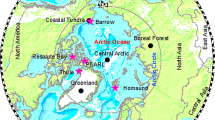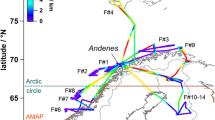Abstract
The Arctic atmosphere is subject to a wide range of local and remote sources of air pollution, which can affect local Arctic communities, contribute to Arctic warming, and cause harm to sensitive Arctic ecosystems. Despite the remote location, the Arctic surface displays characteristic enhancement of air pollutant concentrations during winter and spring known as Arctic Haze. This haze is sourced from long-range transport of pollutants from lower latitudes. During summer, less efficient transport and more efficient pollutant removal leads to lower anthropogenic influence, but increased abundances of naturally-sourced pollutants, including smoke emissions from high latitude wildfires. Long-range transport to the Arctic follows well established pathways, which are determined by dominant meteorological features of the high latitude northern hemisphere. Although poorly constrained at present, local emissions of air pollutants also make important contributions in populated regions, particularly in winter when severe surface-based inversions cause trapping of pollutants close to the surface. Processes controlling secondary pollutant formation under cold, dark conditions are poorly understood at present, and potential novel pathways for oxidant formation and precursor oxidation are under investigation. Impacts of Arctic air pollutants on health may be exacerbated by heavy organic aerosol loadings, and poor underlying health in some local communities. The future evolution of Arctic air pollution will be tightly coupled to both environmental and socioeconomic drivers that will determine Arctic development. Projected reductions of air pollution emissions due to air quality and climate mitigation strategies at lower latitudes are likely to produce warming in the Arctic over the near-term, due to sharp reductions in cooling aerosols.
Similar content being viewed by others
References
Nordenskiöld AE (1883) Baron Nordenskjöld’s Expedition to Greenland. Nature 28:37–41. https://doi.org/10.1038/028037a0
Mitchell JM (1957) Visual range in the polar regions with particular reference to the Alaskan Arctic. J Atmos Terr Phys, Special Supplement 195–211
Barrie LA (1986) Arctic air pollution: an overview of current knowledge. Atmos Environ (1967) 20:643–663. https://doi.org/10.1016/0004-6981(86)90180-0
Stohl A (2006) Characteristics of atmospheric transport into the Arctic troposphere. J Geophys Res Atmos 111. https://doi.org/10.1029/2005JD006888
AMAP (2021) AMAP Arctic climate change update 2021: key trends and impacts. AMAP
Romanovsky VE, Smith SL, Christiansen HH (2010) Permafrost thermal state in the polar Northern Hemisphere during the international polar year 2007–2009: a synthesis. Permafr Periglac Processes 21:106–116. https://doi.org/10.1002/ppp.689
Serreze MC, Barry RG (2014) The Arctic climate system, 2nd edn. Cambridge University Press, Cambridge
Rantanen M, Karpechko AY, Lipponen A et al (2022) The Arctic has warmed nearly four times faster than the globe since 1979. Commun Earth Environ 3:168. https://doi.org/10.1038/s43247-022-00498-3
Shupe MD, Persson POG, Brooks IM et al (2013) Cloud and boundary layer interactions over the Arctic sea ice in late summer. Atmospheric Chem Phys 13:9379–9399. https://doi.org/10.5194/acp-13-9379-2013
Overland JE, Guest PS (1991) The Arctic snow and air temperature budget over sea ice during winter. J Geophys Res Oceans 96:4651–4662. https://doi.org/10.1029/90JC02264
Abbatt JPD, Leaitch WR, Aliabadi AA et al (2019) Overview paper: new insights into aerosol and climate in the Arctic. Atmospheric Chem Phys 19:2527–2560. https://doi.org/10.5194/acp-19-2527-2019
Overland JE, Wang M (2010) Large-scale atmospheric circulation changes are associated with the recent loss of Arctic sea ice. Tellus A 62:1–9. https://doi.org/10.1111/j.1600-0870.2009.00421.x
Willis MD, Leaitch WR, Abbatt JPD (2018) Processes controlling the composition and abundance of Arctic aerosol. Rev Geophys 56:621–671. https://doi.org/10.1029/2018RG000602
Whaley CH, Law KS, Hjorth JL et al (2022) Arctic tropospheric ozone: assessment of current knowledge and model performance. Atmospheric Chem Phys. https://doi.org/10.5194/acp-2022-319
Walker TW, Jones DBA, Parrington M et al (2012) Impacts of midlatitude precursor emissions and local photochemistry on ozone abundances in the Arctic. J Geophys Res Atmos 117. https://doi.org/10.1029/2011JD016370
Macdonald KM, Sharma S, Toom D et al (2017) Observations of atmospheric chemical deposition to high Arctic snow. Atmospheric Chem Phys:5775–5788. https://doi.org/10.5194/acp-17-5775-2017
Ikeda K, Tanimoto H, Sugita T et al (2017) Tagged tracer simulations of black carbon in the Arctic: transport, source contributions, and budget. Atmospheric Chem Phys 17:10515–10533. https://doi.org/10.5194/acp-17-10515-2017
Evangeliou N, Balkanski Y, Hao WM et al (2016) Wildfires in northern Eurasia affect the budget of black carbon in the Arctic – a 12-year retrospective synopsis (2002–2013). Atmospheric Chem Phys 16:7587–7604. https://doi.org/10.5194/acp-16-7587-2016
Schmale J, Sharma S, Decesari S et al (2022) Pan-Arctic seasonal cycles and long-term trends of aerosol properties from 10 observatories. Atmospheric Chem Phys 22:3067–3096. https://doi.org/10.5194/acp-22-3067-2022
Schmale J, Arnold SR, Law KS et al (2018) Local Arctic air pollution: a neglected but serious problem. Earths Future 6:1385–1412. https://doi.org/10.1029/2018EF000952
Eckhardt S, Stohl A, Beirle S et al (2003) The North Atlantic Oscillation controls air pollution transport to the Arctic. Atmospheric Chem Phys:1769–1778. https://doi.org/10.5194/acp-3-1769-2003
Monks SA, Arnold SR, Chipperfield MP (2012) Evidence for El Niño–Southern Oscillation (ENSO) influence on Arctic CO interannual variability through biomass burning emissions. Geophys Res Lett 39. https://doi.org/10.1029/2012GL052512
Monks SA, Arnold SR, Emmons LK et al (2015) Multi-model study of chemical and physical controls on transport of anthropogenic and biomass burning pollution to the Arctic. Atmospheric Chem Phys 15:3575–3603. https://doi.org/10.5194/acp-15-3575-2015
Sharma S, Andrews E, Barrie LA et al (2006) Variations and sources of the equivalent black carbon in the high Arctic revealed by long-term observations at Alert and Barrow: 1989–2003. J Geophys Res Atmos 111. https://doi.org/10.1029/2005JD006581
Wofsy SC, Sachse GW, Gregory GL et al (1992) Atmospheric chemistry in the Arctic and subarctic: influence of natural fires, industrial emissions, and stratospheric inputs. J Geophys Res 97:16731. https://doi.org/10.1029/92JD00622
Atlas EL, Ridley BA, Cantrell CA (2003) The Tropospheric Ozone Production about the Spring Equinox (TOPSE) Experiment: introduction. J Geophys Res Atmos 108. https://doi.org/10.1029/2002JD003172
Law KS, Stohl A, Quinn PK et al (2014) Arctic air pollution: new insights from POLARCAT-IPY. Bull Am Meteorol Soc 95:1873–1895. https://doi.org/10.1175/BAMS-D-13-00017.1
Mölders N, Tran HNQ, Cahill CF et al (2012) Assessment of WRF/Chem PM2.5 forecasts using mobile and fixed location data from the Fairbanks, Alaska winter 2008/09 field campaign. Atmos Pollut Res 3:180–191. https://doi.org/10.5094/APR.2012.018
Simpson W, Law K, Schmale J et al (2019) Alaskan Layered Pollution And Chemical Analysis (ALPACA) white paper 84
AMAP (2015) AMAP Assessment 2015: black carbon and ozone as arctic climate forcers. AMAP
Moschos V, Dzepina K, Bhattu D et al (2022) Equal abundance of summertime natural and wintertime anthropogenic Arctic organic aerosols. Nat Geosci 15:196–202. https://doi.org/10.1038/s41561-021-00891-1
Stohl A, Aamaas B, Amann M et al (2015) Evaluating the climate and air quality impacts of short-lived pollutants. Atmospheric Chem Phys 15:10529–10566. https://doi.org/10.5194/acp-15-10529-2015
Creamean JM, Kirpes RM, Pratt KA et al (2018) Marine and terrestrial influences on ice nucleating particles during continuous springtime measurements in an Arctic oilfield location. Atmospheric Chem Phys 18:18023–18042. https://doi.org/10.5194/acp-18-18023-2018
Law KS, Roiger A, Thomas JL et al (2017) Local Arctic air pollution: sources and impacts. Ambio 46:453–463. https://doi.org/10.1007/s13280-017-0962-2
Huang K, Fu JS (2016) A global gas flaring black carbon emission rate dataset from 1994 to 2012. Sci Data 3:160104. https://doi.org/10.1038/sdata.2016.104
Li C, Hsu NC, Sayer AM et al (2016) Satellite observation of pollutant emissions from gas flaring activities near the Arctic. Atmos Environ 133:1–11. https://doi.org/10.1016/j.atmosenv.2016.03.019
Thorp T, Arnold SR, Pope RJ et al (2021) Late-spring and summertime tropospheric ozone and NO2 in western Siberia and the Russian Arctic: regional model evaluation and sensitivities. Atmospheric Chem Phys 21:4677–4697. https://doi.org/10.5194/acp-21-4677-2021
Winiger P, Andersson A, Eckhardt S et al (2017) Siberian Arctic black carbon sources constrained by model and observation. Proc Natl Acad Sci 114:E1054–E1061. https://doi.org/10.1073/pnas.1613401114
McCarty JL, Aalto J, Paunu V-V et al (2021) Reviews and syntheses: arctic fire regimes and emissions in the 21st century. Biogeosciences 18:5053–5083. https://doi.org/10.5194/bg-18-5053-2021
Palarz A, Celiński-Mysław D, Ustrnul Z (2018) Temporal and spatial variability of surface-based inversions over Europe based on ERA-Interim reanalysis. Int J Climatol 38:158–168. https://doi.org/10.1002/joc.5167
Decesari S, Sowlat MH, Hasheminassab S et al (2017) Enhanced toxicity of aerosol in fog conditions in the Po Valley, Italy. Atmospheric Chem Phys 17:7721–7731. https://doi.org/10.5194/acp-17-7721-2017
Wang Y, Zhang Q, Jiang J et al (2014) Enhanced sulfate formation during China’s severe winter haze episode in January 2013 missing from current models. J Geophys Res Atmos 119:10425–10440. https://doi.org/10.1002/2013JD021426
Campbell JR, Battaglia M, Dingilian K et al (2022) Source and Chemistry of Hydroxymethanesulfonate (HMS) in Fairbanks, Alaska. Environ Sci Technol 56:7657–7667. https://doi.org/10.1021/acs.est.2c00410
Cesler-Maloney M, Simpson WR, Miles T et al (2022) Differences in ozone and particulate matter between ground level and 20 m Aloft are frequent during wintertime surface-based temperature inversions in Fairbanks, Alaska. J Geophys Res Atmos 127:e2021JD036215. https://doi.org/10.1029/2021JD036215
Slater EJ, Whalley LK, Woodward-Massey R et al (2020) Elevated levels of OH observed in haze events during wintertime in central Beijing. Atmospheric Chem Phys 20:14847–14871. https://doi.org/10.5194/acp-20-14847-2020
Dyson JE, Boustead GA, Fleming LT et al (2021) Production of HONO from NO2 uptake on illuminated TiO2 aerosol particles and following the illumination of mixed TiO2/ammonium nitrate particles. Atmospheric Chem Phys 21:5755–5775. https://doi.org/10.5194/acp-21-5755-2021
Wespes C, Emmons L, Edwards DP et al (2012) Analysis of ozone and nitric acid in spring and summer Arctic pollution using aircraft, ground-based, satellite observations and MOZART-4 model: source attribution and partitioning. Atmospheric Chem Phys 12:237–259. https://doi.org/10.5194/acp-12-237-2012
Acosta Navarro JC, Varma V, Riipinen I et al (2016) Amplification of Arctic warming by past air pollution reductions in Europe. Nat Geosci 9:277–281. https://doi.org/10.1038/ngeo2673
Mauritsen T, Sedlar J, Tjernström M et al (2011) An Arctic CCN-limited cloud-aerosol regime. Atmospheric Chem Phys 11:165–173. https://doi.org/10.5194/acp-11-165-2011
Sand M, Berntsen TK, von Salzen K et al (2016) Response of Arctic temperature to changes in emissions of short-lived climate forcers. Nat Clim Change 6:286–289. https://doi.org/10.1038/nclimate2880
Rap A, Richards NAD, Forster PM et al (2015) Satellite constraint on the tropospheric ozone radiative effect. Geophys Res Lett 42:5074–5081. https://doi.org/10.1002/2015GL064037
Marelle L, Raut J-C, Law KS, Duclaux O (2018) Current and future arctic aerosols and ozone from remote emissions and emerging local sources – modeled source contributions and radiative effects. J Geophys Res Atmos 123:12942–12963. https://doi.org/10.1029/2018JD028863
AMAP (2022) AMAP: Arctic Monitoring and Assessment Programme, Assessment 2022: short-lived climate forcers (in press). AMAP, Oslo
Tornevi A, Andersson C, Carvalho AC et al (2021) Respiratory health effects of wildfire smoke during Summer of 2018 in the Jämtland Härjedalen Region, Sweden. Int J Environ Res Public Health 18:6987. https://doi.org/10.3390/ijerph18136987
Stanaway JD, Afshin A, Gakidou E et al (2018) Global, regional, and national comparative risk assessment of 84 behavioural, environmental and occupational, and metabolic risks or clusters of risks for 195 countries and territories, 1990–2017: a systematic analysis for the Global Burden of Disease Study 2017. The Lancet 392:1923–1994. https://doi.org/10.1016/S0140-6736(18)32225-6
Chen G, Guo Y, Yue X et al (2021) Mortality risk attributable to wildfire-related PM2·5 pollution: a global time series study in 749 locations. Lancet Planet Health 5:e579–e587. https://doi.org/10.1016/S2542-5196(21)00200-X
Hirdman D, Sodemann H, Eckhardt S et al (2010) Source identification of short-lived air pollutants in the Arctic using statistical analysis of measurement data and particle dispersion model output. Atmospheric Chem Phys 25
von Salzen K, Whaley CH, Anenberg SC et al (2022) Clean air policies are key for successfully mitigating Arctic warming. Commun Earth Environ 3:1–11. https://doi.org/10.1038/s43247-022-00555-x
Stephenson SR, Wang W, Zender CS et al (2018) Climatic responses to future trans-arctic shipping. Geophys Res Lett 45:9898–9908. https://doi.org/10.1029/2018GL078969
Author information
Authors and Affiliations
Corresponding author
Editor information
Editors and Affiliations
Rights and permissions
Copyright information
© 2023 Springer Nature Singapore Pte Ltd.
About this entry
Cite this entry
Arnold, S.R., Bozem, H., Law, K.S. (2023). Arctic Air Pollution. In: Akimoto, H., Tanimoto, H. (eds) Handbook of Air Quality and Climate Change. Springer, Singapore. https://doi.org/10.1007/978-981-15-2527-8_19-1
Download citation
DOI: https://doi.org/10.1007/978-981-15-2527-8_19-1
Received:
Accepted:
Published:
Publisher Name: Springer, Singapore
Print ISBN: 978-981-15-2527-8
Online ISBN: 978-981-15-2527-8
eBook Packages: Springer Reference Earth and Environm. ScienceReference Module Physical and Materials ScienceReference Module Earth and Environmental Sciences
Publish with us
Chapter history
-
Latest
Arctic Air Pollution- Published:
- 25 May 2023
DOI: https://doi.org/10.1007/978-981-15-2527-8_19-2
-
Original
Arctic Air Pollution- Published:
- 06 May 2023
DOI: https://doi.org/10.1007/978-981-15-2527-8_19-1




